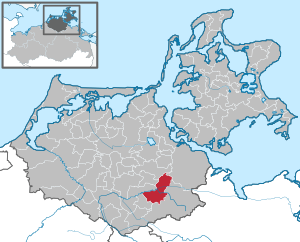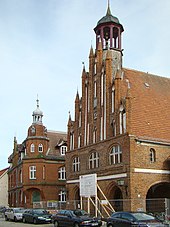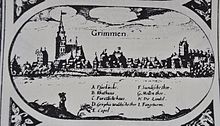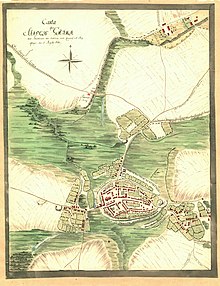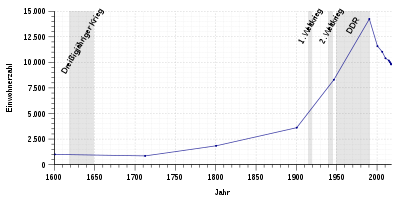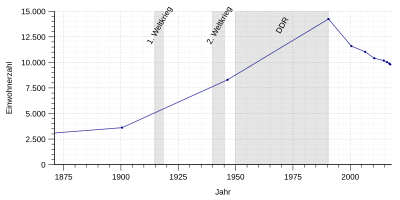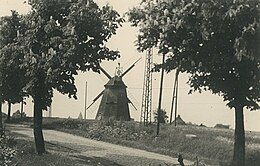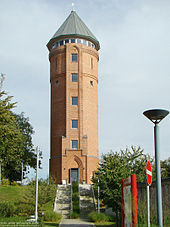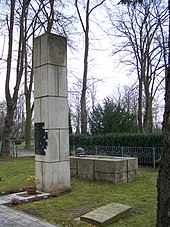Grim
| coat of arms | Germany map | |
|---|---|---|
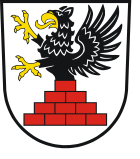
|
Coordinates: 54 ° 7 ' N , 13 ° 2' E |
|
| Basic data | ||
| State : | Mecklenburg-Western Pomerania | |
| County : | Western Pomerania-Ruegen | |
| Height : | 10 m above sea level NHN | |
| Area : | 50.29 km 2 | |
| Residents: | 9489 (Dec. 31, 2019) | |
| Population density : | 189 inhabitants per km 2 | |
| Postal code : | 18507 | |
| Area code : | 038326 | |
| License plate : | VR, GMN, NVP, RDG, RÜG | |
| Community key : | 13 0 73 035 | |
| LOCODE : | DE GMN | |
| City structure: | 12 districts | |
City administration address : |
Market 1 18507 Grimmen |
|
| Website : | ||
| Mayor : | Benno Rüster ( CDU ) | |
| Location of the city of Grimmen in the district of Vorpommern-Rügen | ||
Grimmen is a town in the district of Western Pomerania-Rügen in the state of Mecklenburg-Western Pomerania . It is one of the 18 medium-sized centers in the country and is centrally located between Stralsund and Greifswald , which form a joint regional center.
geography
Geographical location
Grimmen is located in the southern part of the Vorpommern-Rügen district . It is located almost 30 km south of the Hanseatic city of Stralsund and 30 km west of the Hanseatic city of Greifswald . The Jarpenbeek flows into the Poggendorfer Trebel , which borders the old town to the west, directly on the southwestern edge of the old town . Around 800 meters north-west of the old town , it joins the Kronhorster Trebel and forms the beginning of the Trebel river in the urban area .
City structure
The city has the following districts:
Neighboring communities
Neighboring municipalities of the city are (clockwise, starting from the north):
Wittenhagen , Sundhagen , Süderholz , Wendisch Baggendorf , Splietsdorf , Papenhagen
history
Surname
"The oldest forms of the name are Grimmis, Grimme, Grymmis, Grimm." The Polish field name contains the noun grim , which could be translated as an area surrounded by wet meadows . The current spelling only finally established itself 200 years ago. Therefore, the name “Grimmer” for the inhabitants of the city is reminiscent of the earlier spelling of the place name.
middle Ages
From the 9th to the 10th century, the Slavic Lutizen immigrated to the region around Grimmen after the Germanic population settled there had emigrated. The first documented evidence of Slavic (Wendish) settlements in the area of the city of Grimmen can be dated to the year 1220.
Probably after 1250, immigrant traders and craftsmen from Lower Saxony, Westphalia and the Lower Rhine founded the place Grimmen and laid out a grid-shaped road network as planned. Grimmens was first mentioned in a document in 1267. However, today the city was founded when Vogts Berthold settled. He came to the area of today's city of Grimmen in 1287 as a representative of the sovereigns. This proves that Grimmen already held the town charter of Luebeck at that time . However, the actual award document is no longer available today. Accordingly, in 1987 the 700th anniversary of the city of Grimmen was celebrated. In 1305 Grimme was named as stad and in 1306 the city council and the castle exist.
In 1278 Grimmen still belonged to the Schwerin diocese , and a knight Arnold ruled the place. Shortly afterwards, the bishop left Grimmen to the Rügen prince Wizlaw II. , And his town bailiff Berthold runs the town together with the town council. In 1325 - after the death of the last Prince of Rügen - Grimmen came to the Duchy of Pomerania until 1648 .
The city fortifications were built from around 1264 and mainly in the 14th century from 1320 to 1340. The three still existing gate towers date from the 15th century.
The town church of St. Marien is an early Gothic hall church from the second half of the 13th century (1275). The town hall was also built from 1400, and in 1402 a first fair is mentioned. The calender house dates from the 15th century.
The medieval streets were - as archaeologically determined in 2000 - about 1.20 to 2.00 m below today's street level. Roads made of wooden planks (13th century) and field stone paving (14th century) were proven. It was also possible to detect water pipes from this period that were perpendicular to the direction of travel.
16. – 19. century
The Reformation reached Grimmen in 1536 and prevailed in Pomerania (1534, Landtag of Treptow an der Rega ). In 1546, Duke Philipp I von Pommern-Wolgast donated three “booths” to the city in Schulstrasse to provide for the poor, as well as the brickworks, the castle mill and a water mill.
During the Thirty Years' War the city was sacked several times, including by the troops of Wallenstein (1627). In 1630 and 1632 there were also major city fires. In 1631 the Swedes conquered the city. Swedish looting followed in 1637. Grimmen belonged to the Kingdom of Sweden in the following period and formally from 1648 ( Peace of Westphalia ) . During the siege of Greifswald and Stralsund, Friedrich Wilhelm (the Great Elector) had his headquarters in Grimmen, and from October 22, 1659 in Barth . From 1695 to 1697 witch hunts took place under the then mayor Johannes Flittner . At least seven alleged witches were executed. In December 2006 the city of Grimmen installed a relief on the last witch trial against Anna Kröger in 1697 on the administrative building of the city administration, Lange Straße 48.
In 1757 another city fire devastated half the town. As in the Livonian War , Grimmen was occupied by the Prussians in the Seven Years' War from 1757 to 1759. In 1797, almost the entire city was the victim of a large fire that broke out in a forge in the city. In 1800 the Swedish King Gustav Adolf IV visited Grimmen and resided during this time in the so-called royal house . In 1807 the French occupied the city in the Fourth Coalition War against Prussia, Russia and Saxony and destroyed larger areas of the city.
In the final act of the Congress of Vienna in 1815 it was determined that Swedish Pomerania and therefore Grimmen belong to Prussia . A year later, Grimmen became a district town through administrative reform and in 1829 received the district office.
In 1825 the city wall was torn down. In 1838 the district court of Grimmen started its work in a new building. In 1853 the city was ravaged by cholera . In 1878 Grimmen received a railway connection.
In the 19th century, Grimmen grew beyond the town center, which was marked by the removed fortifications, and the Greifswalder suburbs arose in front of the Greifswalder Tor and new settlements in front of the Mühlentor in the direction of the train station at the end of the 19th century. The city park was laid out south of the old town. In 1898 the post office was inaugurated.
20th century
From 1843 to the time of National Socialism (1933–1945) there was a small Jewish cemetery on the edge of Karlstrasse , on which 15 to 20 graves with gravestones were still present in 1938. The last burial took place there in 1922. In 1940 the Nazis had the tombstones removed and leased the land as garden land for civil servants. In 1972 half of the site was leveled and built on. In 2009 a memorial stone was placed on the remaining area covered with fir trees. The city council rejected the laying of stumbling blocks in memory of the murdered Jews in 2018 with the votes of the CDU and SPD.
At the end of the Second World War , Grimmen was handed over to the advancing Red Army in April 1945 without a fight .
Since the 1960s, numerous new factories and farms have sprung up, initiating a brief economic boom. These include VEB Erdöl-Erdgas Grimmen , which was founded in 1962 after workers had encountered an oil deposit in the Zechstein area at a depth of 2,300 meters the year before when they were drilling a well . As a result, the city's population grew steadily and new parts of the city were created, e.g. B. between 1968 and 1985 the large housing estate south-west with 2868 apartments in prefabricated construction .
After the political change, the historic city center and the town hall were fundamentally renovated from 1991 as part of urban development funding; As a result of this renovation, the cityscape appears much more closed than before.
History of the districts
Gross Lehmhagen
The manor belonged to the Barnewitz families and their heirs since 1892 and to the brickworks owner Karl Leitner since 1905. The older, single-storey manor house with a basement was expanded at the end of the 19th century and has a three-storey gable . Since 1945 it has been used as a home for the mentally ill and from 1952 as a retirement and nursing home.
Klein Lehmhagen
The estate was a Prussian state domain , the leaseholder of which was Amtsrat Krooss and, since around 1910, chief bailiff Alwin Müller. The single-storey manor house was extended by a two-storey extension towards the end of the 19th century.
Hohenwarth
Hohenwarth was acquired under the name "Hogenwarde" from the Eldena monastery in 1527 by Lucius Normann from Stralsund for 1,500 marks.
Administrative affiliation
- 1815–1945: District of Grimmen , Province of Pomerania ( Prussia )
- 1945–1952: District of Grimmen, State of Mecklenburg ( SBZ , GDR )
- 1952-1990: Grimmen county , district Rostock (DDR)
- 1990–1994: Grimmen district , Mecklenburg-Western Pomerania
- 1994–2011: District of North Western Pomerania , Mecklenburg-Western Pomerania
- since 2011: District of Vorpommern-Rügen , Mecklenburg-Vorpommern
Until 2011 Grimmen was the district town .
Incorporations
On July 1, 1950, the previously independent communities of Klevenow, Müggenwalde and Stoltenhagen (? - but not until 2004!) Were incorporated. Jessin was also incorporated into Grimmen on July 1, 1950, but hived off on January 1, 1956 and incorporated again on October 1, 1961. Since January 1st, 2004 the municipality of Stoltenhagen belongs to the city of Grimmen. The city of Grimmen has thus added five additional districts.
Population development
|
|
from 1990: as of December 31 of the respective year
politics
City council
The city council of Grimmens consists of 21 members and the mayor. Since the local elections on May 26, 2019 , it has the following composition:
| Political party | Seats |
|---|---|
| CDU | 13 |
| left | 6th |
| SPD | 2 |
mayor
- since 2001: Benno Rüster (CDU)
Rüster was confirmed in the mayoral election on April 26, 2015 with 83.0 percent of the valid votes.
See also: List of Mayors of Grimmen
coat of arms
The coat of arms was determined by the city's magistrate in 1865 and registered under the number 202 of the coat of arms of Mecklenburg-Western Pomerania.
Blazon : "In silver, a floating, four-tier red wall gable from which a black griffin with gold reinforcement grows."
The coat of arms was redrawn in 1998 by the Weimar graphic artist Michael Zapfe .
flag
The city's flag is made of silver (white) cloth and is covered in the middle with the figures of the city's coat of arms in tinging appropriate for the flag. The length of the flag is related to the height as 5: 3.
Town twinning
The city of Grimmen maintains partnerships with five European cities:
- Châteaulin in Brittany , France
- Czaplinek (Tempelburg) in West Pomeranian Voivodeship , Poland
- Kamień Pomorski (Cammin), also in the West Pomeranian Voivodeship
- Staffanstorp in Skåne , Sweden
- Osterholz-Scharmbeck in Lower Saxony
Culture and sights
City center
The historic old town with the grid- shaped street network in an oval city plan is as a whole a remarkable medieval city complex with 72 individual monuments (2001). It is divided into four quarters: The horizontal axis runs between the Mühlentor and the Greifswalder Tor. The vertical axis begins in the north at Stralsunder Tor and runs almost vertically through the old town. The church district is located between this gate and the mill gate due to the sacred buildings ; to the west of it the Kleinleichnamviertel. It is named after a chapel "Zum heiligen Leichnam", which no longer exists today. To the south of this is the Strohviertel, which indicates a settlement with city farms of the arable farmers. The Knochviertel runs east of this quarter between Mühlenstrasse and Buddeliner Strasse. This name indicates that, among other things, the butchers (bone cutters) lived and worked here.
Buildings
Medieval buildings
The old town of Grimmen is architecturally very cohesive and has several brick Gothic buildings , but also interesting buildings from later centuries.
- The parish church of St. Marien was built as an early Gothic brick building with a field stone base from 1267. The originally three-aisled hall church with five bays was supplemented in the 15th century with the three-aisled hall choir. The richly carved pulpit dates from 1707, the guild stalls from 1586. Partial renovations took place inside 1976/77, on the roof in 1986, on the organ in 1982 and 1992, on the hall and tower from 1993.
- The Grimmer Town Hall , built in 1400 in the Gothic style with three ogival arcades , a seven-part ornate gables and an octagonal tower with a supplemented in the 17th century Baroque dome.
- The Kalandhaus (also old school called) west of St. Mary's Church is a late Gothic brick building, the first of the Kaland - Brotherhood was used later as a school building.
- The three square city gates:
- The Stralsund Gate was probably built around 1320 and received a crenellated stepped gable in the 15th century .
- The Mühlentor (also known as Tribseeser Tor) is named after a watermill that was once there. It is an early Gothic brick building with a height of 24.8 meters. The start of construction is estimated to have been around 1325, and renovation with blind gables took place around 1460. The approach of the city wall can still be seen on the gate sides. The gate was restored from 1985 to 1987. Since then, the Grimmen Local History Museum has been located in the gate and in the building adjacent to the south .
- The Greifswalder Tor (probably around 1350 to 1400), incompletely rebuilt after being destroyed in 1800 by a lightning strike. The gate was sometimes also called "Loitzer Tor" because it was on the medieval Hanseweg from Loitz to Stralsund. This Hanseweg led through Grimmen to the Stralsund Gate. To the north of the gate, one last free-standing piece of the city wall can be seen.
- On the Schlossberg stood a building, first mentioned in 1306, which served as the residence of the bailiffs and officials of the sovereign. During excavations, the foundations of a larger building were found - probably a main house that burned down in 1637. Remains of a Gothic archway were also found directly at the water tower. It is not yet known whether this is part of the castle tower that stood until the 18th century.
18th and 19th centuries
- “Neuberlin”, an old town street outside the city wall between the Stralsunder Tor and the Mühlentor.
- The church shack is a listed half-timbered house at Schulstrasse 6. It was built in 1819 on behalf of the church in order to provide affordable living space for needy residents.
- Rectory from 1738 at Domstrasse 7
- Half-timbered house Norderhinterstrasse 11
- School from 1848
20th century
- The brick-faced house 3 of the city administration from 1909/1912 in the Buddeliner Straße next to the town hall shows the typical style of the turn-of-the-century buildings around 1900.
- The department store Mühlenstrasse 8 from 1910.
- Some decaying brick buildings stand north of the city center.
- The city's water tower, built in 1933, stands near the Greifswalder Tor on the so Schlossberg.
- The Grammar School Grimmen, which was built in 1993, is worth mentioning.
- Hohenwarth manor from around 1910 with park.
Parks
- Grimmen has an animal park in which over 250 animals from 50 different species can be viewed. The park was opened in 1957 and is characterized by a large variety of plants and green spaces.
- Another urban green area, the Volkspark, is located near the train station.
Monuments
- War memorial in honor of the Prussian soldiers who died in the Wars of Unification
- The monument to the Reich Chancellor Prince Otto von Bismarck was in the cemetery grounds. The statue was designed by the sculptor Cuno von Uechtritz stone church in the art foundry of Lauchhammer works in bronze casting process produced and unveiled on November 6 1,902th The statue was melted down during World War II.
On May 5, 1953, a memorial for the theorist and journalist Karl Marx was erected at the location of the Bismarck memorial . A boulder with his portrait serves as a memorial stone. - Soviet cemetery of honor on Bahnhofstrasse for 16 Soviet soldiers
- Memorial plaque on the administration building for Anna Kröger, who was executed in 1697. She was the last woman to be accused of being a witch in Grimmen and to be publicly burned.
- Cenotaph from 1968 in Bahnhofstrasse for the victims of fascism
- Sculpture group Baggus Speckin from 2001
Museums
- Local history museum Grimmen "Im Mühlentor"
- Archaeological exhibition in the water tower
archeology
- In Klein Lehmhagen there is an internationally important find site of Lower Jurassic vertebrates. Here, Emausaurus, the only dinosaur in Mecklenburg-Western Pomerania to date was discovered. In 2013, students from the Ernst Moritz Arndt University of Greifswald made another dinosaur discovery at the same location.
- Grellenberg tower hill
- Grimmen Tower Hill (under the water tower)
- Gross Lehmhagen tower hill
Economy and Infrastructure
Companies
- The BEKRU plants were established in 1991 as a manufacturer of windows, doors and components.
- The e.dis energy directed in 1996 its regional center in one of Pomerania.
- The IBC Solar operates a large solar power plant in Grimmen since of 2010. The associated 19-hectare photovoltaic solar park extends over part of the city's former clay dump and is designed to supply 2,200 households with renewable energy.
- The Conergy AG completed by the end of 2011, the second solar park with a planned capacity of 8.2 megawatts of renewable electricity for about 3,000 households.
- The Prolupin GmbH , the 2010 from the Fraunhofer Institute for Process Engineering and Packaging was founded, has its production facilities in Grimmen. The company produces vegan foods in which mainly milk, but also other animal components are replaced by the protein of the local sweet lupins.
traffic
Grimmen is located on the federal highway B 194 between Stralsund and Demmin as well as on the state roads L 19 to Sanitz and L 30 to Stahlbrode . The closest motorway junctions are Grimmen-West and Grimmen-Ost on the A 20 ( Rostock - Neubrandenburg ).
The Grimmen station is on the Berlin – Stralsund railway line and is served by the RE 5 regional express line ( Stralsund – Berlin – Wünsdorf –Waldstadt).
schools
With the primary school “Dr. Theodor Neubauer ”and the primary school“ Friedrich Wilhelm Wander ”two educational institutions of the primary level as well as with the regional school“ Robert Koch ”and the grammar school Grimmen two further institutions with partly large catchment area. Furthermore, a general special school for pupils with special educational needs in the area of learning, a music school and a district folk high school are located in the city.
Social facilities
- SOS village community from 1999 in the Hohenwieden district with several supervised residential communities and a large workshop for people with learning disabilities.
Churches
There are four Christian communities in Grimmen:
- Evangelical parish of St. Marien with the central Marienkirche .
- Catholic Church of St. James, which the parish of Mary Queen of the Rosary in Demmin belongs
- New Apostolic Church
- Evangelical Free Church Congregation ( Baptists )
Sports
Grimmen has sports clubs in the areas of handball, soccer, volleyball, athletics, bowling and judo.
- The HSV Grimmen was founded in 1992 as handball club. His greatest success in 2007 was the promotion of the first men's team to the Regionalliga Nordost. The 2010/11 season ended the team as runner-up in the Mecklenburg-Vorpommern regional league. The male A-youth of HSV Grimmen has been the record state champion of the Mecklenburg-Western Pomerania Association with seven titles since 1998.
- The Grimmener SV was founded in 1992. It emerged from the associations BSG Einheit Grimmen , VEB Bau Grimmen and BSG Erdöl Erdgas Grimmen . The strongest section is the football department. Their first men's team has played in the Mecklenburg-Western Pomerania Association League since the 2010/11 season .
- The soccer club SV Traktor Stoltenhagen , founded in 2004, plays its point games in the regional league of Northern Pomerania / Rügen.
- The JSV Grimmen is the home of organized volleyball. The men's team competes in the Mecklenburg-Vorpommern Association League in the 2015/2016 season. The women's team has played in the Regionalliga Nord since the 2014/2015 season.
- The KSV Grimmen and its Judo section have achieved national importance since the association was founded in 2005 through numerous competition successes. The association currently has almost 100 members. (Status 2011).
media
- A local edition of the Ostsee-Zeitung appears in the city .
- Since 2012 the citizens' television station Grimmen TV (formerly TV Radio Grimmen) has been broadcasting a regular program with news and cultural contributions on the Internet and in the regional cable network.
Personalities
sons and daughters of the town
- Karl Ludwig Droysen (1756–1831), doctor of theology and writer
- Ludwig Dietrich Karl von Schmalensee (1762–1826), Prussian major general
- Dietrich Karl Ludwig von Schmalensee (1768–1857), Prussian lieutenant general
- Gottlieb Mohnike (1781–1841), theologian, philologist and translator of Scandinavian literature
- Bernhard Hinrichs (1819 – after 1867), born in Jessin, was a landowner and member of the constituent Reichstag of the North German Confederation
- Hermann Kirchhoff (1825–1890), architect
- Felix von Behr-Bandelin (1834–1894), manor owner, court official and colonial politician
- Gustav Röseler (1880 – after 1948), engineer and politician (CDU)
- Oskar Munzel (1899–1992), General
- Kurt Wüstenberg (1906–1997) lawyer, judge at the Federal Court of Justice
- Fred Willamowski (1935–2003), motorcycle racer
- Wolfgang Müns (* 1945), literary scholar, Germanist and historian
- Helmuth Furch (* 1947), teacher, cultural worker, author
- Ines Müller (* 1959), athlete (shot put) and Olympic participant
- Heike Götz (* 1964), journalist and presenter at NDR
- Haik Thomas Porada (* 1972), historian
Personalities who lived and worked in Grimmen
- Philipp Jakob von Balthasar (1726–1807), theologian, pastor and church historian
- Johann Flittner (1618–1678), pastor and hymn poet
- Wilhelm Kirchhoff (1800–1861), lawyer, poet and long-time mayor of the city of Grimmen
- Gustav von Hagenow (1813–1876), lawyer, district administrator of the Grimmen district and member of the Frankfurt National Assembly
- Arthur Becker (1862–1933) politician (SPD), landowner and farmer
- Otto Waterstradt (1888–1972), mayor and museum founder in Grimmen
- Walther Koß (1904–1945), editor of the Grimmener Kreiszeitung, honorary archivist and local researcher
- Harry Glawe (* 1953), politician (CDU), Economics Minister of Mecklenburg-Western Pomerania and chairman of the CDU parliamentary group
- Ralf Drescher (* 1956), politician (CDU), district administrator for the district of Northern Western Pomerania
- Marcel Gerds (* 1983), tax advisor and editor-in-chief, attended grammar school in Grimmen until he graduated from high school
literature
- Gustav Kratz : The cities of the province of Pomerania - an outline of their history, mostly according to documents . Berlin 1865, pp. 225–229 ( full text. )
- Erhard Grohmann: Grimmen in old views (Volume 1 and Volume 2). European Library Verlag, Zaltbommel / NL, ISBN 90-288-6581-0 .
- BIG-Städtebau: Grimmen - 10 years of urban renewal , 2001, Stralsund.
- Grimmen , Stadt-Bild-Verlag, Leipzig, 2009, ISBN 978-3-942146-00-5 .
Web links
Individual evidence
- ↑ Statistisches Amt MV - population status of the districts, offices and municipalities 2019 (XLS file) (official population figures in the update of the 2011 census) ( help ).
- ↑ Grimm. Numbers on www.grimmen.de
- ^ F. Kohls: The place and field names of the Grimmen district (Western Pomerania) . Bamberg 1930.
- ^ A b c Haik Porada, Leibniz Institute for Regional Geography, Leipzig
- ↑ Illustration of the relief
- ↑ Reinhard Amler: Grimmen does not want any stumbling blocks. In: Ostsee-Zeitung. July 13, 2018, accessed April 28, 2019 .
- ^ Hermann Hoogeweg : Monasteries in Pomerania. Part 1, Stettin 1924, p. 547.
- ↑ Municipalities 1994 and their changes since January 1, 1948 in the new federal states , Metzler-Poeschel publishing house, Stuttgart, 1995, ISBN 3-8246-0321-7 , publisher: Federal Statistical Office.
- ^ StBA: Changes in the municipalities in Germany, see 2004.
- ↑ Population development of the districts and municipalities in Mecklenburg-Western Pomerania (Statistical Report AI of the Statistical Office Mecklenburg-Western Pomerania)
- ↑ the city council election on May 26, 2019
- ^ Result of the mayoral election on May 20, 2001
- ↑ Benno Rüster wins big. In: Ostsee-Zeitung , April 27, 2015.
- ^ Website of the city
- ↑ Greifswald student discovered second dinosaur from Mecklenburg-Western Pomerania , accessed on May 2, 2013
- ^ Homepage of the SOS village community in Grimmen.
- ↑ The church belongs to the Demmin parish , see St. Marienkirche in Grimmen.
- ↑ Homepage of TV Radio Grimmen.

